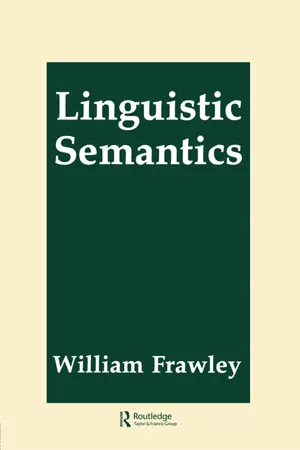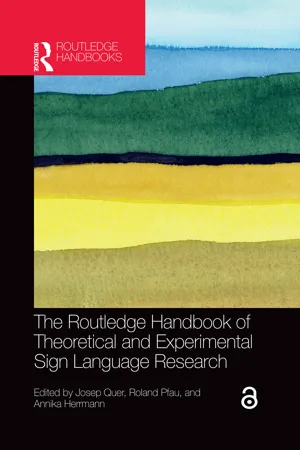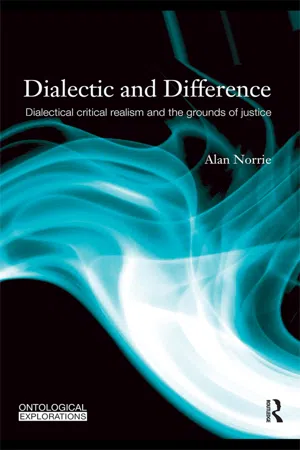Languages & Linguistics
Definition by Negation
Definition by negation is a method of defining a concept by stating what it is not. This approach helps to clarify the boundaries and characteristics of a concept by highlighting what it does not encompass. By identifying what is excluded from the definition, it provides a clearer understanding of the concept being defined.
Written by Perlego with AI-assistance
3 Key excerpts on "Definition by Negation"
Learn about this page
Index pages curate the most relevant extracts from our library of academic textbooks. They’ve been created using an in-house natural language model (NLM), each adding context and meaning to key research topics.
- eBook - ePub
- William Frawley(Author)
- 2013(Publication Date)
- Routledge(Publisher)
In this introduction to modality, we have defined modality as the factual status of a statement. As such, modality subsumes a wide range of notions, including possibility, obligation, negation, hypotheticality, doubt, attitude, and the like. We have differentiated modality from mood, the latter a grammatical device for marking clausal relationships whose denotations sometimes reflect modal notions. Finally, we have considered modality in terms of the two parameters of realis and irrealis, which in turn are subsumed by the larger framework of modality as epistemic deixis. Modality requires a reference world, an expressed world, and remoteness and direction between the two. In many languages, this deictic structure surfaces purely in the realis/irrealis distinction; in others, these parameters overlap with tense, person, and specificity.9.2. NEGATION 9.21. Logical Denial and Propositional NegationThe kind of negation that is usually studied under semantic considerations is propositional negation (sometimes called sentential negation : see Payne 1985; the basic terminology is from Klima 1964). This is the linguistic counterpart of logical denial, determined by the law of double negation : two logical denials produce a positive.We can see the presence of logical denial in the following examples:5a. The dog did not eat. b. The dog never ate.Examples (5a) and (5b) both mean ‘it is false that the dog ate.’ Despite the different means for effecting propositional negation, not versus never, both expressions follow the test for logical denial because the negation of each results in a positive proposition:6 a. The dog did not not eat. (= the dog ate) b. The dog did not never eat. (= the dog ate)The effects of double denial make propositional negation stand out against other kinds of negatives, like affixal negation, the attachment of a bound negative marker to a lexical item. Consider (7), with affixal negation on the adjective:Let us deny (7) to see if the proper positive effect falls out:7. Bob is unhappy.8. Bob is not unhappy.Not unhappy is not equivalent to happy because a not unhappy person is not thereby happy, but could be simply in a normal mind set (see Langendoen and Bever 1973 for the classic study; Horn 1989: 273–308). Thus nonpropositional negation, as in (7), does not involve logical denial because the effect of double negation does not produce a positive result (see also the discussion of scope, sec. 9.22).9.211. The Informational Structure of Propositional Negation - Josep Quer, Roland Pfau, Annika Herrmann, Josep Quer, Roland Pfau, Annika Herrmann(Authors)
- 2021(Publication Date)
- Routledge(Publisher)
12Negation
Theoretical and experimental perspectives
Kadir Gökgöz12.1 Introduction
There is not a single human language without a linguistic way of expressing negation. That is to say, negation is a universal component of the Human Language Capacity; no matter whether a language surfaces through the oral or the manual channel. Thus, it is no surprise that negation has been among the first research topics that sign language researchers either directly pursued or used as a diagnostic for their argumentation concerning other aspects of sign language grammar (Liddell 1980; Padden 1983; Veinberg & Wilbur 1990). By now, various valuable contributions have been made by investigating the morphology, syntax, semantics, prosody, acquisition, and neurolinguistics of negation in the field of sign language research. The sheer number of available studies makes it difficult to choose what to highlight within the space allotted for this chapter. Nonetheless, an effort will be made to review the state of the art of research on sign language negation in a concise yet comprehensive way.I will start by addressing theoretical perspectives on the syntax of negation (Section 12.2 ). Here, I first review the syntactic position of the negative head (Neg°) and, when relevant, the position of its specifier across various sign languages (Section 12.2.1 ). So far, researchers have generally depended on the position of negation vis-à-vis the verb, modals, aspectual markers, and elements in the Complementizer Phrase domain. I will summarize these discussions and review the data in light of a syntactic universal, the Final-Over-Final Constraint, which is a novel perspective on the issue. In Section 12.2.2 , I turn to non-manual markers of negation and the lexical and morpho-syntactic roles that they are argued to play. Generative work on sign language negation has led to recent formal approaches to typological variation, which I will review in Section 12.2.3 . Subsequently, in Section 12.3 , I address experimental perspectives on sign language negation. Section 12.3.1 provides an overview of how children acquire negation, and Section 12.3.2 covers another developmental topic, namely the development of negation in homesign. Finally, Section 12.3.3 offers a review of neurolinguistic studies of sign language negation. Section 12.4- eBook - ePub
Dialectic and Difference
Dialectical Critical Realism and the Grounds of Justice
- Alan Norrie(Author)
- 2009(Publication Date)
- Routledge(Publisher)
denies), rather than from what a particular state of being is, and this is carried forward into our usage. It signifies ‘doing’ more than ‘being’. ‘Negativity’ is something that attaches to, or describes a mood of, being rather than constituting a state of being in itself. Negativity is not so much the same as non-being as depicting one of its attributes. As an abstract noun, it retains something of its active doing quality, rather than the idea that something ‘is not’ in an existential sense, as both ‘absence’ and ‘nonbeing’ signify. These semantic differences are not spelled out by Bhaskar in Dialectic, but I hope it has been worthwhile to explore them here because of the discomfort that some have experienced with Bhaskar’s usage. This may simply be the force of habit among dialectical thinkers in particular, who naturally are drawn to terms like ‘negativity’ and ‘negation’. It may also be linked to the discomfort some feel in simply giving ‘what is not’ such a pivotal role in philosophy. Since Bhaskar argues that absence has been significantly marginalised in the western tradition, we might expect this. It may otherwise simply be a slight clumsiness in sometimes using absence as a verb, ‘to absent’. ‘Absenting absence’ does not trip off the tongue quite as readily as Hegel’s ‘negating the negation’. Whatever, it seems to me that Bhaskar, as a theorist who prioritises ontology, has good reason to switch to absence if he is going to speak of real non-being in a sustained way. In terms of English linguistic usage, there may be no perfect term, but absence works, first, because of its direct link to (non-)being and ontology, and second, because of the availability of a related verb. As competitor-words, ‘negativity’ shares the latter advantage of a verb (‘negate’/‘negation’) but not the former, the clear link to real ontology, to real non-being


